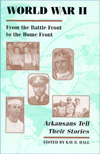

 |

|

The average rating for World War II : From the Battle Front to the Home Front, Thirty-Five Arkansans Tell Their Stories based on 2 reviews is 3 stars.
Review # 1 was written on 2011-11-03 00:00:00 Jim Kitts Jim KittsThis is essentially short chapters on Vanderbilts of the 19th and early 20th century, and some other players during that same time. I guess you might call each a vignette or maybe even an amuse bouche - that delightful (or at least hopefully interesting) little hors d'œuvre in a fancy schmancy restaurant served before the meal really begins. Each chapter on a Vanderbilt or Other Personage is an amuse bouche that may interest you in reading more about that particular person. Or perhaps the entire book is an amuse bouche, and the main meal is - what? Something by Edith Wharton or Henry James? A marathon session of Downton Abbey? Regardless, the book is a real treat. Especially as Louis Auchincloss name drops the entire way through, and with good reason - he's related to half of the people he's writing about. It's Roots for WASPs, or at least this particular WASP. In a chapter about Louis C. Tiffany and his famous costume balls: "I know an old French lady, a survivor of the era, who coined a term for such goings-on: silly-clever." Or, in the chapter on The Mrs. Astor: "I remember once, one a two-hour drive with her grandson... suggesting that we kill the time by trying to re-create her personality." This man knew of what he wrote and spoke, perhaps the last one to do so definitively and knowledgeably. You might say that what he writes is "hearsay" (or even gossip) but since 1989 hearsay has become history. |
Review # 2 was written on 2016-11-03 00:00:00 Travis Wilson Travis WilsonThis entertaining social history looks at the years 1880 through 1920 and is set largely in or near New York. The author’s primary subjects, beginning with Cornelius Vanderbilt, are four generations of a family who at one time controlled $200 million, “the largest fortune in America if not the world.” While Auchincloss’ research is obviously extensive, he conveys his erudition with a light touch and in a concise style. In general, as in his novels the author’s subject is how money is made and spent. Especially striking here, however, are the portraits Auchincloss paints. Cornelius Vanderbilt “was puffed up with divine greed,” as a contemporary wrote. Gertrude Vanderbilt was an arts patron who instigated a scandalous battle for custody of her niece, Gloria Vanderbilt. Harold Stirling Vanderbilt was a champion yachtsman and “the father of contract bridge.” In some cases, more interesting than the Vanderbilts are other individuals Auchincloss describes. These include the historian Henry Adams and his brothers, infamous speculator Jay Gould, the artists Augustus Saint-Gaudens, John Singer Sargent and Louis C. Tiffany, the diplomat Henry White, the architect Stanford White and the author Edith Wharton. Auchincloss is notably good at relating her major novels to the era. |
CAN'T FIND WHAT YOU'RE LOOKING FOR? CLICK HERE!!!